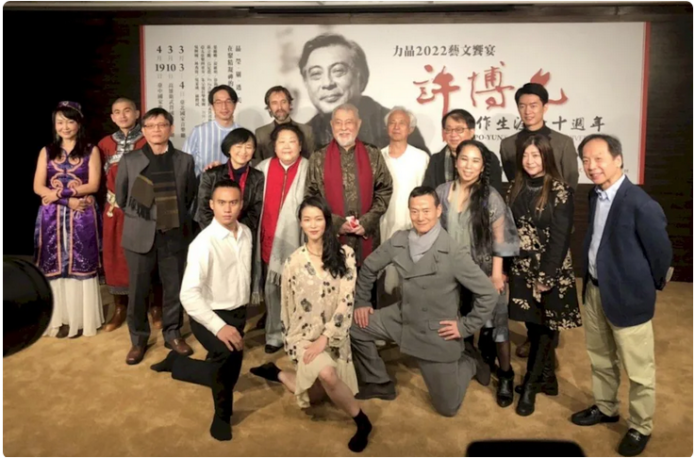The last two weeks have been a bit of a rollercoaster for me. When we were about to launch the Taiwan Overtone Singing Association (TOSA) I received an unexpected invitation that was highly relevant to our new association. I was approached by the office of New Aspect Creatives (新象.環境), founded and led by Hsu Po-Yun (許博允). In Taiwan’s music world, and far beyond it, everybody knows this composer-impressario. This 79-year old maestro started a career as a self-made avant-garde composer in the late 1960s and 1970s, until he became so much absorbed in work with his music agency New Aspects that almost no time was left for composing. Since then, New Aspects became the organisation to bring the great performers of the time to Taiwan. Big names, such as Margaret Argarich, Ravi Shankar and Placido Domingo.
The question was if I would be able to help out replacing the throat singer(s) that could not come to Taiwan, due to the pandemic? I offered the name of the only person I know of here to be able to do it, Unid, a young and talented Taiwanese student of Mongolian throat singing and the horse-head fiddle (morin-khuur), besides my own experience in various kinds of Tuvan and Mongolian throat singing. Two weeks ago I sat down with Mr. Hsu Po-Yun and his staff to discuss the realisation of an early work of his as a composer, written in 1977, called《境》, a single Chinese character that was originally translated as Mood, Field and has now been re-christened as Mood, Field, Mind, Environment. Although it does not explicitly ask for throat singing, it has been performed several times with a Mongolian long-song (urtyn duu) singer and a throat singer (khöömiich). The upcoming performances were all organised in a short time: the first concert in Taipei was less than three weeks away when we first met. Last week I attended a press conference at the National Theater. Meanwhile we have had the first (and last) two rehearsals. So I will be joining this project as a throat-singer, together with a long-song singer they found here in Taiwan, Thumentsetseg, and the young Taiwanese throat singer. The other main role in this piece is for the top percussion ensemble of Taiwan, Ju Percussion Group /朱宗慶打擊樂團 – and a mixed chorus.
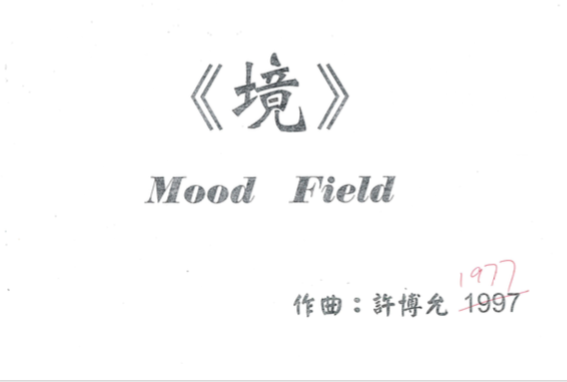
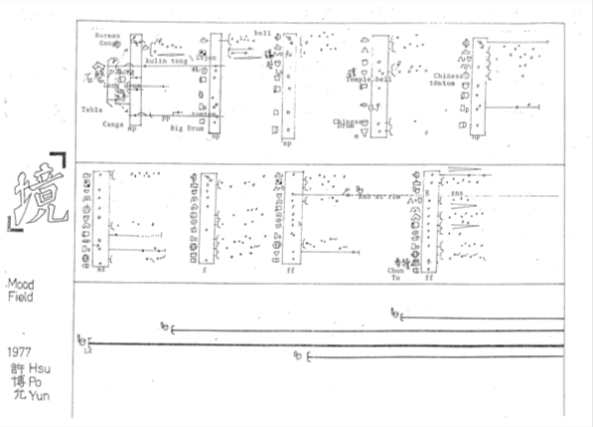
Title page and first page of the score, which had mistakenly been labeled with 1997.
The timing of this invitation hardly could be better. One of the reasons we are founding TOSA is to make overtone singing in all its varieties better known. One thing I hope to achieve is to get composers interested to write new work that includes overtone singing, throat singing (and, by extension, Jew’s harps, tambura or any other conventional or traditional instrument that make special use of timbre and overtones). And behold, our association has just come to life and a big-name composer and agency holds concerts in the three major music halls of Taiwan, namely in Taipei (north), Kaohsiung (south) and Taichung (center), featuring two throat singers.
The other synchronicity is that early this year I picked up a work on Mongolian songs by ethnomusicologist Alain Desjacques, one of the few ‘Westerners’ to make in-depth studies of Mongolian music based on fieldwork in Soviet times. That book contains a CD and the lyrics and transcriptions of 18 Mongolian songs, with some truly wonderful melodies and original voices – the kind of hardcore grassroots stuff that most trained singers performing onstage can’t beat. I thought I should dig a bit more into the two genres presented in the book, the short song or bogino duu and long song or urtyyn duu, and upgrade my improvisations around the long-songs, which I have loosely imitated and incorporated in my singing for about a decade. I wasn’t quite thinking to present myself as a singer of long songs, but working alongside an actual long song singer from Inner Mongolia and using some elements of it in this performance does help to push me a bit more in that direction. (Even more striking is another invitation nearly at the same time to collaborate on a piece by an Inner-Mongolian composer, who also explicitly asked me for throat singing and long-song – the synchronicity was almost too good to be true).

Seeing the date 1977 of Hsu Po-Yun’s piece, I immediately began to think: this may well be the earliest work of new music incorporating throat singing outside Mongolia and Siberia / Russia. The Russian improviser-composer Micha Alperin is known for such cross-over work in the late 1980s (with Tuvan throat singers). He influenced Guus Janssen who created an opera with Tuvan throat singers in the early 1990s, and at the same time several well-known collaborations of the Tuvans started happening in the US (Frank Zappa, Kronos Quartet, Ry Cooder). But this Taiwanese piece was at least a decade earlier, at a time when foreigners hardly had access to or direct knowledge of traditional overtone-throat singing. When I asked mr. Hsu about the earliest performance, it turned out the 1977 version did not include any throat singers. The piece was commissioned by the NHK or Japanese broadcasting organisation and the vocal parts were taken care of by their own in-house chorus. For the extra traditional flavor he wished for, they had arranged for singers from the Ainu, the original, indigenous inhabitants of modern-day Japan. But as Mr. Hsu also told me, he did hear Mongolian throat singing in Japan already at that time, in 1977 or earlier, while working on his project. That must have been one of the rare visits of Mongolian singers abroad, which was especially rare outside the Soviet states (inside the Soviet Union and its satellite states, there was plenty of travel and work-exchange to encourage the brotherhood-of-peoples ideal). Later on, Hsu Po-Yun managed to bring throat-singers over to Taiwan, and he visited Mongolia himself some twenty times, by his own account, including one visit with Placido Domingo.
This synchronicity of the start of TOSA, the performance of Hsu’s work in three cities of Taiwan, and the other invitation to contribute voice recordings for an electro-acoustic work) is one of those moments when you feel an angel is watching over your shoulder. Most important of all: the music of Hsu Po-Yun I got to know is indeed ‘full of charm and power,’ just as we were asked to say in a promo-video. The main role is for the percussion group, the players are the absolute top, the scoring is very imaginative and varied, with dozens of different instruments. And the singing part, well: come and check it out, if you can. There is another interesting work of Hsu performed live next month, the opera Medea, which he presented us on CD and also sounds quite appealing to me.


What makes this series extra exciting is that I am going to perform in the fantastic new performing art centers in Taichung and Kaohsiung. The latter has opened very recently and was co-developed by the Dutch architect agency of Francine Houben. For the best views, check their Mecanoo site, here is a family snapshot taken a few weeks ago inside the arched corridors.
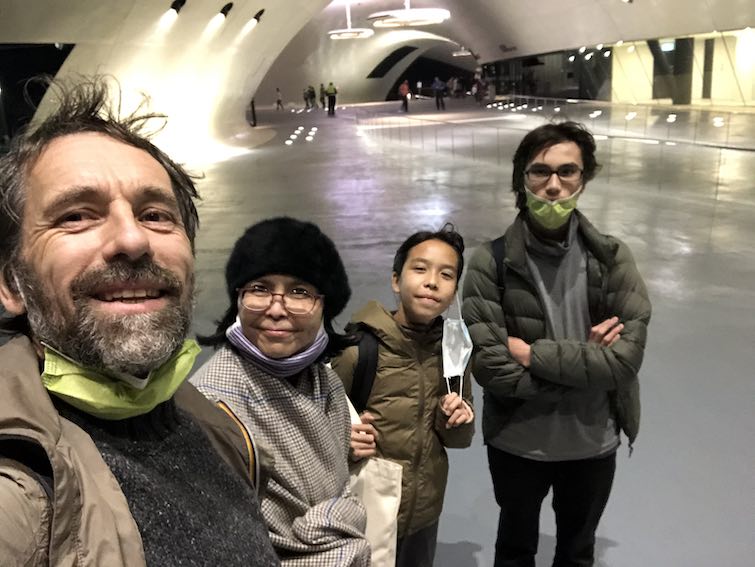
Above: Last month June invited us all to watch Bellini’s opera Norma in the new Kaohsiung Performing Arts Center; a few months earlier we saw Ricardo Canzio play in Astor Piazzolla’s opera María de Buenos Aires in another hall of this center Below: November 2016, at one of the opening performances of the Taichung National Theatre, designed by architect Toto Ito.
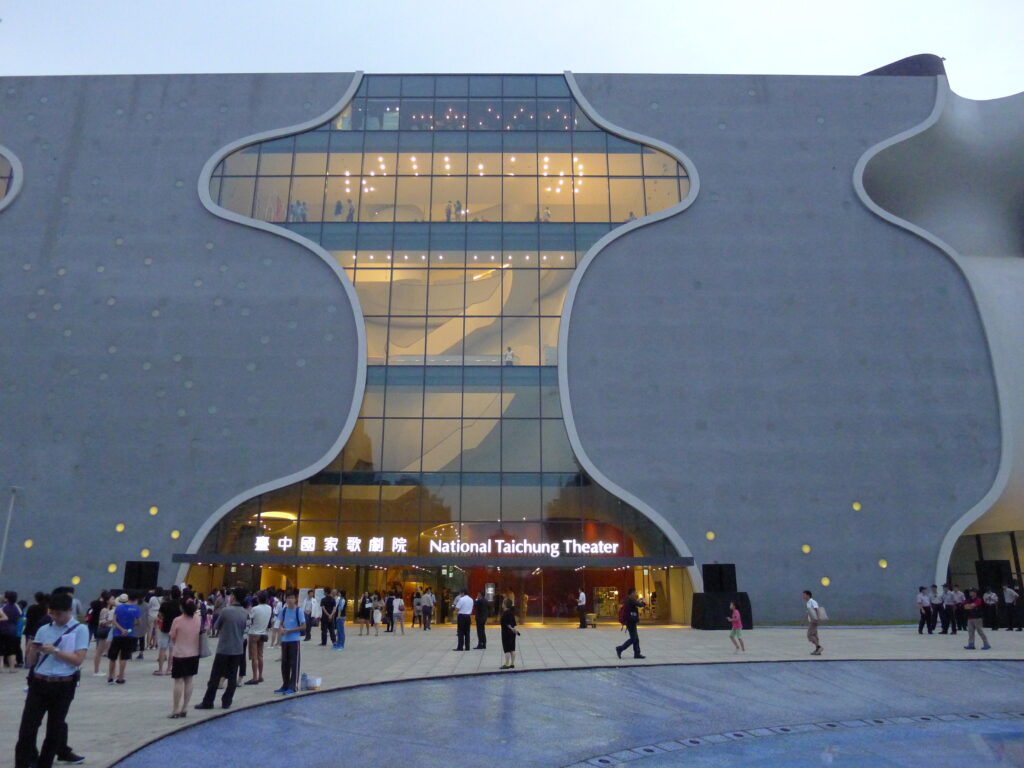
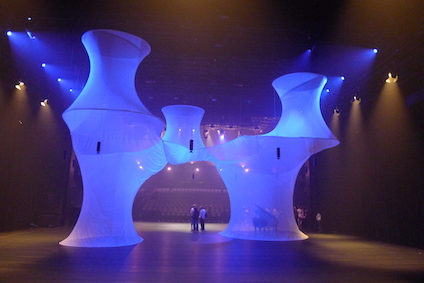
A radio interview with Chechena Kuular for Radio Taiwan International, about my involvement in this piece, is planned for next week.
Powerchip 2022 Classical Series:
HSU PO-YUN’ a 60th Musical Anniversary
March 3rd and 4th at National Concert Hall, Taipei
March 10th at Weiwuying Concert Hall
April 19th at the Grand Theatre of National Taichung Theatre
【力晶 2022藝文饗宴 許博允創作生涯六十週年】
3月3號、4號台北國家音樂廳
3月10號 高雄衛武營國家音樂廳
4月19號 台中國家歌劇院大劇院
Here is the blurb from the impressario’s website.
https://www.newaspect.org.tw/2022hsupoyun
晶.瑩.剔.透.美
力晶2022藝文饗宴:許博允創作生涯六十週年
HSU Po-Yun’s 60th Musical Anniversary
03 / 03 (四) - 03 / 04 (五) 19:30 臺北國家音樂廳
National Concert Hall, Taipei
03 / 10 (四) 19:30 高雄衛武營國家音樂廳
Weiwuying Concert Hall
04 / 19 (五) 19:30 臺中國家歌劇院大劇院
Grand Theater, National Taichung Theater, Taichung
一顆顆音符,
誕生於無限延展的時空天地,
凝聚了宇宙洪荒的冥想與思索……
許博允的音樂,來自純真的靈魂深處,是生命的引路人。他以老莊哲學為體、現代音樂筆法為用,有時歌頌自然善美,有時吟詠歷史滄桑;有時探究邏輯道理,有時觀照心扉人情。他探究生命的實現,點染了大千世界的奧妙,帶領聽者返璞歸真。
讓我們在聚精凝神的音韻中,隨哲思作曲家許博允,聽見世界萬象。
創作生涯六十年 開創東方音樂新藝境
在以藝術推展為畢生職志之前,許博允先是個作曲家。童年闔家聽戲的耳濡目染,青年投入許常惠門下、深入邊地的民族采風,成年後遊歷各國的藝術之旅、發掘世界各地新星藝術家時展現的獨到眼光,加上不論年輕或成熟、愉快或憂愁,都對世間萬物擁懷的信念與好奇心,皆讓他的音樂創作及人生省視,比旁人更多了萬千風姿、一份真情。
許博允的創作,彷彿夜幕低迴時,仰望博大精深的星空──
他熱愛古今中外交融碰撞的火花,就在《寒食》中編入融合蒙古吟唱、京劇聲腔、日本能劇及西方聲樂的高難度唱腔。
他力求突破創新,《琵琶隨筆》就匯聚了古往今來的琵琶技巧,並首創了前所未見的高超技法。
他熟稔東方源遠流長的音樂歷史,以中國八音、超過百種樂器、蒙古呼麥及臺灣原住民獨特聲腔創作《境》。
他內省人性的雙重性格,於是誕生了《心》,讓陰與陽、柔與剛的心緒,在小提琴與鋼琴清麗的旋律中,偶然交會、互動,綻放光亮。
他渴探天地的組織運行,就以《點.線.面.體》拓展了聲音的維度,以擊樂的「點」、弦樂的「線」,編織成多重立體的聲響境界。
豐富多彩的人生歷練,成就了許博允的綺想世界。從民歌採集、藝文展演到邊境行旅,藝術之路上的每顆星星,都成為了他作品星系中獨一無二的光輝!
藝壇翹楚跨界共製 淬鍊最晶瑩剔透的時光
《許博允 創作生涯六十週年》邀集表演藝術各大領域頂尖藝術家──鋼琴家葉綠娜、小提琴家黃維明、大提琴家陳建安、長笛家胡志瑋、琵琶家黃立騰、歌者 Fu-Fu 許維城、西塔琴家金光亮平、呼麥及馬頭琴藝術家烏尼德、長調藝術家圖孟其其格與范.湯可鄰 Mark van Tongeren,攜手國寶藝術家吳興國、女力舞蹈家林秀偉、新生代舞者吳采璘與絲釋民、時尚服裝設計師溫慶珠、造型服裝藝術家康延齡,更有亞太弦樂四重奏、朱宗慶打擊樂團共襄盛舉,並重現已故大師──前輩男中音張清郎珍貴的歷史錄音,精選作曲生涯中最為雋永、值得反覆思索的《琵琶隨筆》《心》《寒食》《點線面體》《境》,以及全新創作的器樂獨奏曲,融匯詩意與形貌,跨越時間與空間,帶來結合器樂、人聲、舞蹈、戲劇的多元跨界展演。
音樂是一切的根源,也蘊含強大的襯托能量,創造多重的藝術境界。許博允的音樂,是純粹原真,也能如繁星綻放永恆光芒!
Sparked from the depth of his soul, composer-philosopher Hsu Po-Yun’s music is dedicated to explore the realisation of life and mysteries of the world. While his rich experiences, firm conviction and everlasting curiosity reveals greater flair and genuineness in his compositions and philosophy, his infusion of the East and West – of Chinese Eight Sounds, Mongolian kohmei, Tibetan Brāhma, Peking opera vocal techniques, Tang Elegant Music and Japanese Noh and Western instruments and vocals – have chimed across time and space and forged a new path in music. The celebration of his 60th musical anniversary is a crossover production by Fan Man-Nong, Lin Hsiu-Wei, Wu Hsing-Kuo, Lina Yeh, Ju Zong-Ching, the most elite in the artistic field. Their interpretation of Hsu’s classics and new works is not only transcendental, but a multifaceted presentation of music, dance and theatre.
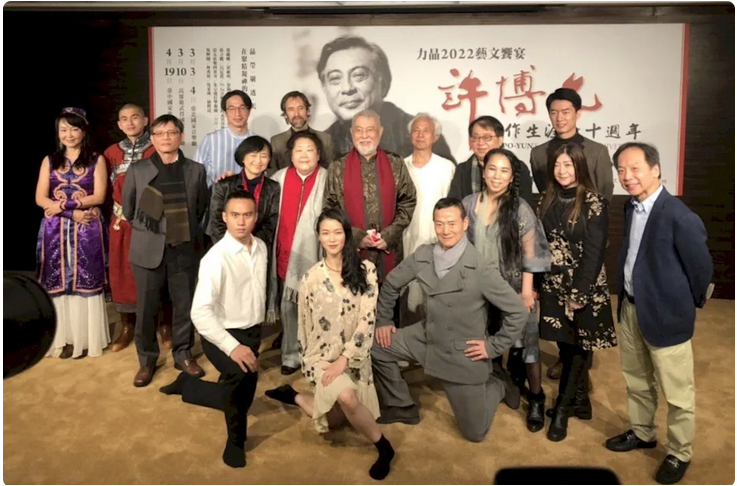
The press conference was as much an intimate celebration of Hsu Po-Yun’s 60 years in the music industry by long-time collaborators, such as Lien Hsin-Sheng from the Asian Composer’s League, Tzong-Ching Ju, founder of Ju Percussion, Wu Hsing-Kuo of Contemporary Legend Theater and many others.
The blurb from Yahoo in Manadarin:
https://tw.news.yahoo.com/許博允創作生涯60週年樂展-開創東方音樂新藝境-070136205.html

在力晶文化基金會熱情支持下,【力晶二○二二藝文饗宴-許博允創作生涯六十週年】樂展呈現了許博允創作生涯一甲子的音樂盛會,邀集表演藝術各大領域頂尖藝術家:鋼琴家葉綠娜、小提琴家黃維明、大提琴家陳建安、長笛家胡志瑋、琵琶家黃立騰,攜手女力舞蹈家林秀偉、影視劇國寶吳興國、新生代舞者吳采璘及絲釋民,亞太弦樂四重奏、朱宗慶打擊樂團共襄盛舉,並重現已故大師-前輩男中音張清郎珍貴的歷史錄音,精選作曲生涯中最為雋永、值得反覆思索的《琵琶隨筆》、《心》、《寒食》、《點線面體》,更有《境》的呼麥暨馬頭琴藝術家烏尼德、蒙古長調歌者圖孟其其格、荷蘭泛音詠唱藝術家馬克‧范‧湯可鄰(Mark van Tongeren),以及許博允獻給妻子樊曼儂的全新創作《長笛隨想曲》,融匯詩意與形貌,跨越時間與空間,帶來結合器樂、人聲、舞蹈、戲劇的多元跨界展演;三月三至四日於臺北國家音樂廳演出、三月十日於高雄衛武營國家音樂廳演出、四月十九日於臺中國家歌劇院大劇院演出,更多活動詳情請洽詢官網。(見圖)\\;
許博允的音樂不僅展現現代音樂的精神,更成為國內外的許多戲劇、舞蹈製作創意發想的泉源。一九七二至一九七五年,許博允創作《中國戲曲冥想》、《寒食》、《琵琶隨筆》與《生‧死》,陸續成為「雲門舞集」主要舞碼《烏龍院》、《寒食》、《夸父追日》、《哪吒》的音樂;許博允之音樂透過「雲門舞集」在全世界公演超過四百次,各地讚嘆,一九八五年林懷民以《寒食》為該創作獨舞《夢土》,無限延長的白色衣絹,勾勒介之推內心糾結的約束與包袱。一九八○年代,「菲律賓國家舞蹈團」藝術總監-蕊蕬、美國舞蹈家-莫里路易斯、日本默劇家-箱島安及旅美電動雕塑家-蔡文穎都相繼使用許博允之音樂編作。\\;
新象文教基金會董事長樊曼儂感謝「力晶文化基金會」鼎力支持這次音樂會,也感謝藝文界好友們的支持;豐富多彩的人生歷練,成就了許博允的綺想世界,從民歌採集、藝文展演到邊境行旅,藝術之路上的每顆星星都成為了他作品星系中獨一無二的光輝!
許博允將古今中外交融碰撞的火花融入編曲,《寒食》中編入融合蒙古吟唱、京劇聲腔、日本能劇及西方聲樂的高難度唱腔;他力求突破創新,《琵琶隨筆》就匯聚了古往今來的琵琶技巧,並首創了前所未見的高超技法;他熟稔東方源遠流長的音樂歷史,以中國八音、超過百種樂器、蒙古呼麥及臺灣原住民獨特聲腔創作《境》;他內省人性的雙重性格,於是誕生了《心》,讓陰與陽、柔與剛的心緒,在小提琴與鋼琴清麗的旋律中,偶然交會、互動,綻放光亮;他渴望探索天地的組織運行,就以《點‧線‧面‧體》拓展了聲音的維度,以擊樂的「點」、弦樂的「線」,編織成多重立體的聲響境界。


